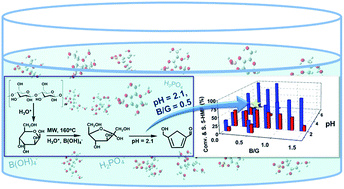Condition screening and process investigation of aldose transformation in borate-containing acidic phosphate buffer system under microwave irradiation†
Abstract
The highly selective isomerization and dehydration of various carbohydrates (glucose, xylose, cellobiose and cellulose) are one-pot conversions conducted in a simple borate-containing phosphate buffer solution (PBS) under microwave irradiation. It is demonstrated that the key to glucose converting into 5-hydromethylfurfural (5-HMF) with a high selectivity is matching the isomerization and dehydration processes of glucose at the appropriate boron/glucose mole ratio (B/G) and pH of PBS with the aid of microwave irradiation. Moreover, the interaction between borate and glucose in the isomerization process has been demonstrated by both Raman spectra and theoretical calculations. Furthermore, the reusability of such a PBS system with borate has been accomplished by the successive addition of glucose and by the continual removal of 5-HMF in a biphasic system. These results not only deepen the understanding of the isomerization and dehydration behavior of glucose, but also provide the possibility for practical applications, owing to the appealing green, inexpensive and sustainable characteristics of such a catalytic system.



 Please wait while we load your content...
Please wait while we load your content...